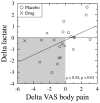Effect of Milnacipran Treatment on Ventricular Lactate in Fibromyalgia: A Randomized, Double-Blind, Placebo-Controlled Trial
- PMID: 26335989
- PMCID: PMC4630071
- DOI: 10.1016/j.jpain.2015.08.004
Effect of Milnacipran Treatment on Ventricular Lactate in Fibromyalgia: A Randomized, Double-Blind, Placebo-Controlled Trial
Abstract
Milnacipran, a serotonin/norepinephrine reuptake inhibitor, has been approved by the US Food and Drug Administration for the treatment of fibromyalgia (FM). This report presents the results of a randomized, double-blind, placebo-controlled trial of milnacipran conducted to test the hypotheses that a) similar to patients with chronic fatigue syndrome, patients with FM have increased ventricular lactate levels at baseline; b) 8 weeks of treatment with milnacipran will lower ventricular lactate levels compared with baseline levels and with ventricular lactate levels after placebo; and c) treatment with milnacipran will improve attention and executive function in the Attention Network Test compared with placebo. In addition, we examined the results for potential associations between ventricular lactate and pain. Baseline ventricular lactate measured by proton magnetic resonance spectroscopic imaging was found to be higher in patients with FM than in healthy controls (F1,37 = 22.11, P < .0001, partial η(2) = .37). Milnacipran reduced pain in patients with FM relative to placebo but had no effect on cognitive processing. At the end of the study, ventricular lactate levels in the milnacipran-treated group had decreased significantly compared with baseline and after placebo (F1,18 = 8.18, P = .01, partial η(2) = .31). A significantly larger proportion of patients treated with milnacipran showed decreases in both ventricular lactate and pain than those treated with placebo (P = .03). These results suggest that proton magnetic resonance spectroscopic imaging measurements of lactate may serve as a potential biomarker for a therapeutic response in FM and that milnacipran may act, at least in part, by targeting the brain response to glial activation and neuroinflammation.
Perspective: Patients treated with milnacipran showed decreases in both pain and ventricular lactate levels compared with those treated with placebo, but, even after treatment, levels of ventricular lactate remained higher than in controls. The hypothesized mechanism for these decreases is via drug-induced reductions of a central inflammatory state.
Trial registration: ClinicalTrials.gov NCT01108731.
Keywords: Widespread pain; brain function; magnetic resonance spectroscopy; serotonin-norepinephrine reuptake inhibitor.
Copyright © 2015 American Pain Society. Published by Elsevier Inc. All rights reserved.
Figures




References
-
- Ciccone DS, Natelson BH. Comorbid illness in the chronic fatigue syndrome: A test of the single syndrome hypothesis. Psychosom Med. 2003;62:268–275. - PubMed
-
- Cohen J. Eta-squared and partial eta-squared in fixed factor ANOVA designs. Educational and psychological measurement. 1973
-
- Drossman DA. The functional gastrointestinal disorders and the Rome III process. Gastroenterology. 2006;130:1377–1390. - PubMed
-
- Duyn JH, Gillen J, Sobering G, van Zijl PC, Moonen CT. Multisection proton MR spectroscopic imaging of the brain. Radiology. 1993;188:277–282. - PubMed
-
- Fan J, McCandless BD, Sommer T, Raz A, Posner MI. Testing the efficiency and independence of attentional networks. J Cognit Neurosci. 2002;14:340–347. - PubMed
Publication types
MeSH terms
Substances
Associated data
Grants and funding
LinkOut - more resources
Full Text Sources
Other Literature Sources
Medical

